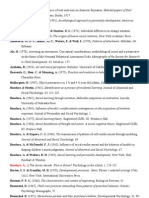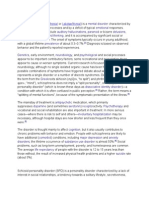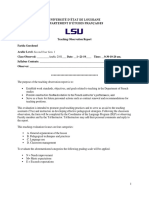Shyness Crozier
Shyness Crozier
Uploaded by
kennethCopyright:
Available Formats
Shyness Crozier
Shyness Crozier
Uploaded by
kennethOriginal Description:
Copyright
Available Formats
Share this document
Did you find this document useful?
Is this content inappropriate?
Copyright:
Available Formats
Shyness Crozier
Shyness Crozier
Uploaded by
kennethCopyright:
Available Formats
State of the art
Shyness
T is not difficult to conjure up an image
of a shy child, tongue-tied and staring
at the floor when asked a question by
an adult; or hovering at the periphery of a
game, perhaps peering from behind mother
at the other childrens activities. Nor is it
difficult to imagine a shy adolescent or
adult, minimally involved in a social event,
avoiding eye contact, not speaking unless
spoken to, talking in a soft voice.
Such images are familiar because
shyness is a pervasive social phenomenon.
It is used by many to describe an important
facet of their character, and it influences
interpretations of behaviour believing that
someone is shy deflects explanations of
apparently unsociable behaviour in terms
of conceit, rudeness, unfriendliness or lack
of interest in others. Nevertheless, it has
attracted systematic investigation only in
recent years. In part, this neglect reflects
uncertainties about definition; shyness is
an everyday expression with no precise
meaning, and psychologists have not always
been convinced that it is any more than this.
But everyday conceptions of shyness
have been investigated scientifically,
largely from psychological and linguistic
perspectives. The Stanford Shyness Survey
(Zimbardo, 1977) asked respondents
whether they regarded themselves as shy,
and it explored their sense of what shyness
entails. The survey revealed widespread
agreement on this shyness is a matter
of quietness, inhibited behaviour, selfconsciousness, and apprehension about
being negatively evaluated in social
WEBLINKS
Craigs Shyness Resource Page:
www.csbruce.com/~csbruce/shyness
Helping young children to overcome shyness:
www.personal.une.edu.au/~jmalouff/shyness.html
Social Anxiety: www.messages.social-anxiety-uk.com
The Shyness Institute, Palo Alto, California:
www.shyness.com
Shyness site for children and their parents:
www.shykids.com
Shyness and Society: Susie Scott, Cardiff Uni:
www.cf.ac.uk/socsi/shyness/index.html
W. RAY CROZIER investigates the links between shyness
and behavioural inhibition.
situations. Nearly all respondents reported
feeling shy at one time or another and
a sizeable proportion (40 per cent)
described themselves as shy persons. There
is evidence from cross-cultural studies of
language that concepts of feeling shy and
being shy are found in societies across the
world and consistently refer to uncertainty
about what to do or say and concerns about
being evaluated by others (Harkins, 1990).
There has also been research aimed at
framing and testing hypotheses about
shyness. This article identifies two
approaches corresponding, by and large, to
whether shyness in adulthood or childhood
is the focus. From this research a distinction
emerges between fearful and self-conscious
forms of shyness. I discuss how this
distinction might relate to the reticence
that seems such a feature of shyness.
Shyness as a trait
This approach defines shyness in
psychometric terms. Questionnaire
measures have been constructed (the
most widely used is that of Cheek and
Buss, 1981). These have proved to be
substantially intercorrelated and seem to
measure a common factor, one that is
distinct from introversion or lack of
sociability (Crozier, 2001a). Scores on
these questionnaires predict behaviour (e.g.
Cheek & Buss, 1981; Crozier, 2001a). Shy
children and adults are more reticent than
their peers in social situations they are
slower to produce their first utterance in
conversation with an unfamiliar person,
they take longer to break a silence, their
utterances are shorter and less elaborate,
and they speak for a smaller proportion of
the time. They make less eye contact and
touch the face and body more with their
hands.
Of course, even those who are
extremely shy are not shy all the time
shyness is experienced in social situations,
particularly those involving meeting new
people or having to speak up in front of an
audience (Asendorpf, 1989). Furthermore,
shyness has cognitive, affective and
behavioural components. There is variation
among individuals in the relative
prominence of these components in their
shyness for some, shyness is largely
concern over the appropriateness of their
behaviour, for others it is affective
concerns, including somatic symptoms
such as blushing, sweating and trembling.
An alternative trait approach regards
shyness as a form of social anxiety, a
broader construct that also encompasses
embarrassment, stage fright and social
phobia. This approach also adopts a threecomponent conception of social concerns.
Leary (1986) emphasises two of these
components in defining shyness as a
psychological syndrome that includes both
subjective social anxiety and inhibited
social behavior (p.29). He relates shyness
to self-presentation concerns. Those who
are shy are motivated to create a desired
impression in others but lack confidence
that they will be able to do so. This is why
shyness is distinct from lack of sociability
(where there is less motivation to impress),
and why shyness should be elicited in
some situations but not others (those where
impression management concerns are
salient or where confidence is low, e.g.
dating, attending an interview, speaking up
in front of others). It captures the conflict
described by shy people they want to join
in or speak up, but feel held back.
This impression management account
also suggests why shyness so often takes
the form of reticence the shy person is
preoccupied with the impression that will
be created by what he or she might say.
Better to say nothing than to risk the
disapproval of others or rejection by them.
460
The Psychologist
Vol 15 No 9
September 2002
State of the art
These concerns can be illustrated by
a participant in one of my own studies:
I felt inadequate. I believed I was too
young to say anything that would have
been of the slightest interest to these
people. I felt awkward as if out of
place When anybody did ask me
something I would be so concerned
about how to reply that I could feel
myself heating up and turning red.
(Crozier, 2001b, p.1)
The construct of social anxiety has figured
more frequently than shyness in clinical
research into social phobia. This is a
common clinical condition in adulthood
some 13 per cent of the adult population
will meet diagnostic criteria at some time
in their life (Kessler et al., 1994). The
condition can be also identified among
children (Rapee & Sweeney, 2001). The
concerns of social phobics are similar to
those expressed by shy individuals fear
of novel and evaluative social situations
and fear of behaving in ways that will lead
to embarrassment. The difference is
perhaps one of degree. Social phobia is
associated with considerable distress and
disruption of everyday life, whereas shy
people report difficulties rather than
impairment of social functioning
(Zimbardo, 1977). Social phobia can
impinge on mundane activities like eating
and drinking in public, occasions rarely
mentioned by the shy as causing distress.
Whereas clinical researchers have been
comfortable with the concept of social
anxiety they have regarded shyness with
some wariness, suspecting it refers in a
loose way to social fears of various kinds
and degrees. This is in contrast with social
phobia, which is defined in terms of a set
of explicit diagnostic criteria. Nevertheless,
clinical researchers have begun to take
shyness seriously and to consider its links
with social phobia (e.g. McNeil, 2001).
One reason is recognition of the prevalence
of shyness in everyday explanations of
social difficulties. More significant,
perhaps, is the influence of research into
behavioural inhibition, to which I now turn.
Behavioural inhibition and
shyness
A substantial programme of research
initiated by Jerome Kagan at Harvard
has investigated individual differences in
temperament that appear at an early age.
Studies show variation in emotional
reactivity during the first months of life
that predicts subsequent differences in
a temperament Kagan has labelled
behavioural inhibition to the unfamiliar.
Inhibition is not equivalent to shyness
Kagan regards it as a reaction to novel
events of all kinds, not just unfamiliar
social encounters but shyness-eliciting
situations increasingly become the stage for
inhibited responses. A childs encounters
with unfamiliar adults or children play a
large part in the assessment of behavioural
inhibition. Furthermore, outcome measures
in this research include reticence, hesitation
in making spontaneous contributions to
conversation and tendencies to hover at the
edge of social situations, as well as ratings
of shyness made by parents or observers of
the childs behaviour.
Kagan argues that inhibition originates
in the childs greater reactivity to threat. He
assigns a central role in this heightened
reactivity to limbic structures, particularly
the amygdala and its projections (Kagan,
Shy people make less eye contact and touch
the face and body more with their hands
1994). The model has generated
predictions about individual variation in
peripheral physiological response systems.
These have largely been tested with
measures of heart rate and heart rate
variability, although other measures have
been used such as cortisol levels and, more
recently, frontal brain EEG activity
(Davidson & Rickman, 1999).
Differences between shy or inhibited
and less shy or uninhibited individuals are
also found on variables that seem remote
from wariness in novel situations. More
children with blue eyes are found in
samples of inhibited children than are
expected on the basis of the distribution
of blue eyes in the population. Reactive
infants have narrower faces than less
reactive infants. Those who are shy and
inhibited (and their close relatives) are
more susceptible to allergies like eczema
and hay fever and to certain medical
conditions, for example Parkinsons disease
(Bell et al., 1995). Evans (2001) reports
a significant trend for shy children to
be absent more frequently from school
through illness, particularly gastrointestinal
conditions. The meanings of these
correlations warrant further study; Kagan
(1994) has speculated on the role of genetic
factors that influence variation in the levels
of norepinephrine and dopamine,
neurotransmitters that play a key role in the
regulation of sympathetic nervous system
activity.
This research programme has made
effective use of longitudinal studies. These
show that inhibition assessed at one age
predicts inhibition and shyness at another
(e.g. Kerr, 2000). There is evidence that
behavioural inhibition in early childhood is
a risk factor for the development of social
phobia in adolescence (Schwartz et al.,
1999). Nevertheless, inhibition in the early
years does not lead remorselessly to later
shyness. Some children become less shy
and others more so. Clearly, children
encounter different kinds of social
situations as they grow older, and shyness
will take a different form for the toddler
than for the schoolchild or the young
person seeking friendships or romantic
attachments. This has implications for the
measurement of shyness and for estimates
of its stability. It also raises questions about
changes in the nature of shyness as
children grow older; and we now consider
this issue.
Two kinds of shyness?
We have noted that shyness in adulthood
involves concerns with the impression
made on others, with being negatively
evaluated by others, and with being
embarrassed. Although young children can
undoubtedly be shy, no researcher imagines
that this is due to self-presentation
anxieties, believing that such anxieties
require cognitive, emotional and social
attainments that are not reached by that
age. How could young children be shy if
they lack the maturity necessary to have
self-presentation concerns?
One answer is that there are two forms
of shyness, one that appears early in life
(and is represented in the studies of early
inhibition) and that continues to exert an
influence on behaviour, and another that
emerges somewhat later in development.
Buss (1986) has labelled these forms
fearful and self-conscious shyness. The
latter appears when children acquire
a theory of mind and they are able to
reflect on their own behaviour from
different perspectives and become
461
September 2002
The Psychologist
Vol 15 No 9
State of the art
conscious of themselves as social actors.
There is evidence of relevant changes in
childrens understanding of shyness, where
self-conscious concerns are apparent by
about five years. Yuill and Banerjee (2001)
invited children to say which was more
likely to make a child shy meeting a
stranger or singing alone in front of the
class. A majority of five- and six-year-olds
selected the latter option.
However, fearful shyness is not
superseded by the self-conscious form.
References to both forms are found in
content analysis of interviews with older
children and adults (Crozier, 1999). There
is also evidence from studies that involve
a peer-nomination technique where
children cast other children for parts in
a school play, drawing on descriptions of
behaviours characteristic of shyness
(generated by a different sample of
children). In a factor analysis of the
nominations, the descriptive item someone
who doesnt talk much to other kids
loaded on an inhibited/wary factor,
whereas the item someone who doesnt
answer questions in class had high
loadings on a separate self-conscious/
anxious factor (Younger et al., 2000).
Claims for two kinds of shyness are
not new Baldwin (1894) distinguished
primary or organic bashfulness from
true bashfulness, the latter appearing at
around three years of age. Lewis (2001)
has proposed a similar classification of
types of embarrassment. Exposureembarrassment is evident at an early age,
for example in a childs coyness at seeing
herself in a mirror. It emerges prior to
evaluation-embarrassment, which can be
seen around the third year if a child fails to
meet standards of evaluation, for example,
making a faux pas. True bashfulness and
evaluation-embarrassment both involve
self-consciousness; how this develops is
as yet little understood. Presumably, it
requires the capacity to view the self as if
through the eyes of others. This might be
contingent on developments in perspective
taking that occur around the age that new
forms of shyness and embarrassment can
be identified.
It is not yet known whether the
distinction between fearful and selfconscious shyness means that there are
two types of situations (novel or evaluative)
that elicit a common state of shyness, or
whether there are distinct states. Nor is it
clear whether the emergence of the selfconscious form implies that there are
children who had not hitherto been shy
and who become shy at this stage, yielding
different types of shy child. Asendorpf
(1989) has argued for a common state,
while Younger et al. (2000) claim that their
peer-nomination measure differentiates two
types of children.
Why are shy children quiet?
The distinction between fearful and selfconscious shyness also leads to different
answers to this question, with varying
emphasis on fear
and self-conscious
concerns.
Kagan (2001)
has likened
inhibition of
speech to an
animals freezing
reaction in novel
situations.
However, if
freezing is a
response to
novelty, children
should become
less quiet as they
become
increasingly familiar with a range of social
situations. Something must override the
influence of familiarity so that even routine
encounters can elicit shyness.
Another answer is that inhibited
children have a physiology that produces
more intense emotional reactions. They
become aware of these reactions, come to
anticipate them and attribute them to their
own shortcomings (Kagan, 2001). This
predisposition results in more intense fear
of criticism and rejection and a greater
tendency to perceive social situations as
threatening to the self. This fear produces
wariness, a suspension of activity in a
threatening situation accompanied by
increased vigilance while the extent of the
threat is assessed.
Compatible with a self-conscious
conception of shyness is the finding that
when older children or adolescents are
asked about their quietness, they report
fears about making mistakes in front of
their peers, about being the centre of
attention, and about being embarrassed.
Potential contributions to the conversation
are rehearsed but are rejected in
anticipation that they will be thought banal,
inadequate or inappropriate. But we do not
know whether the production of utterances
is inhibited (one is quiet despite oneself) or
silence is strategic a protective selfpresentation ploy or a safety behaviour
(Clark & Wells, 1995).
Shy children are justified in being
concerned about self-presentation:
reticence, like any behaviour, has social
meanings and consequences. A child who
has acquired a habit of being quiet finds
that others notice and interpret that
quietness for example, children with
delayed language development tend to be
rated as shy by their parents (Paul &
Kellogg, 1997). Quiet children might be
labelled as shy, a label that they might
adopt for themselves. They become
conscious of being different from others,
who appear to them to be naturally
talkative, and perhaps believe that they
are failing to fulfil the expectations of
significant others in a society that places
a high value on social confidence.
Some hint of the pressures of social
expectations can be gleaned from
interpretations of sex differences in
shyness. Stevenson-Hinde and Shouldice
(1993) have reported that parents find
shyness less acceptable in sons than in
daughters, especially as boys grow older.
Kerr et al. (1994) report greater temporal
stability of inhibition among girls, and
suggest that this reflects cultural pressures
on boys to be less shy. Kerr (2000) argues
that this interpretation is supported by
evidence of the differential impact of
shyness on significant life transitions for
men and women. Shy men marry and have
children somewhat later than non-shy men
(but there is no equivalent trend for
women), and shy American men enter
stable careers later than women (a finding
not mirrored in Sweden where, Kerr
argues, shyness is less negatively
evaluated).
Overcoming shyness
First, it must be acknowledged that many
shy people see no need to overcome their
shyness. They may regard it as a positive
personal quality or as an aspect of their
personality to which they have adjusted.
It is essential to bear this in mind in the
context of recent media publicity for
pharmacological cures for shyness
(usually referring to studies claiming that
selective serotonin reuptake inhibitors have
been effective in the treatment of social
phobia). There is a danger that such
publicity promotes the view that shyness is
somehow abnormal, deviant or an illness.
Nevertheless, there is evidence that, for
large numbers of people, shyness is a
persistent problem that they would
overcome if they could (Zimbardo, 1977).
Epidemiological research is needed to
confirm whether there are substantial
numbers of people who experience
462
The Psychologist
Vol 15 No 9
September 2002
State of the art
significant levels of social anxiety but who
do not meet criteria for social phobia (or
who would meet them if they were
assessed) and who would benefit from
access to psychological help.
A number of effective psychological
techniques for overcoming social anxiety
are available: anxiety management
techniques; social skills training; cognitive
therapies (which challenge the negative
assumptions, beliefs and interpretations
that help maintain social fears); and
exposure exercises (where fear of a
particular class of social situations, e.g.
public speaking, is extinguished by
repeated exposure to such situations
without the feared consequences).
These methods are applied to the
treatment of social phobia and may not be
readily available to shy people, or their
existence known to them. There are some
community-based programmes specifically
targeted at shyness, for example, the Palo
Alto Shyness Clinic (Henderson &
Zimbardo, 1998), and websites, self-help
books and telephone help lines that point
people in the direction of help, support
groups, and so on (see Weblinks box). It
would be valuable to compile, and make
accessible a directory of these resources.
The research summarised in this article
can contribute to methods for overcoming
shyness. It advances the understanding of
the nature, origins and development of
shyness that provides the necessary
underpinning for effective intervention.
Establishing that there are different forms
of shyness can result in focused techniques
targeted at individuals with distinct profiles
of shyness programmes like that offered
by the Shyness Clinic tend to be broadbased and draw upon a range of treatments.
The distinction between fearful and selfconscious shyness offers a promising
approach to developing such profiles.
Looking ahead
The construct of shyness has heuristic
value. There has been a surge in research,
whether influenced by Kagans theory of
behavioural inhibition or undertaken within
a trait perspective. Nevertheless, there are
many issues about the nature of shyness to
be resolved. Longitudinal studies are
needed to map in detail changes in shyness
across the years of childhood. We have
to understand better the psychological
significance of the distinction between
shyness related to timidity and wariness,
and shyness related to self-consciousness
and embarrassment. We do not know how
the two forms of shyness relate to each
other, or how inhibited children negotiate
the self-presentation challenges they
increasingly face as they grow older. We
do not yet understand the processes that
mediate between shyness and reticence. In
my own work we are approaching this by
manipulating the social context in which
children make verbal responses to tasks
(Crozier & Hostettler, 2001). We do not
know whether these processes are the same
at different ages or for all shy individuals.
Shyness raises fundamental questions
about the self, social relationships and
social interaction processes, and research
continues to draw productively from a
range of perspectives, from personality
theory, psychophysiology and social,
clinical and developmental psychology.
Dr W. Ray Crozier is at the School of
Social Sciences, Cardiff University. E-mail:
crozier@cardiff.ac.uk.
References
Asendorpf, J.B. (1989). Shyness as a final
common pathway for two different
kinds of inhibition. Journal of Personality
and Social Psychology, 57, 542549.
Baldwin, J.M. (1894). Bashfulness in children.
Educational Review, 8, 434441.
Bell, I.R.,Amend, D., Kaszniak,A., Schwartz,
G.E., Peterson, J.M., Stini,W.A. et al.
(1995).Trait shyness in the elderly:
Evidence for an association between
Parkinsons disease in family members
and biochemical correlates. Journal of
Geriatric Psychiatry and Neurology, 8, 1622.
Buss,A.H. (1986).A theory of shyness. In
W.H. Jones, J.M. Cheek & S.R. Briggs
(Eds.) Shyness: Perspectives on research
and treatment (pp.3946). New York:
Plenum.
Cheek, J.M. & Buss,A H. (1981). Shyness and
sociability. Journal of Personality and
Social Psychology, 41, 330339.
Clark, D.M. & Wells, A. (1995).A cognitive
model of social phobia. In R. Heimberg,
M. Liebowitz, D.A. Hope & F.R. Schneier
(Eds.) Social phobia: Diagnosis,
assessment and treatment (pp.6993).
New York: Guilford Press.
Crozier,W.R. (1999). Individual differences
in childhood shyness. In L.A. Schmidt &
J. Schulkin (Eds.) Extreme fear, shyness,
and social phobia: Origins, biological
mechanisms, and clinical outcomes
(pp.1429). New York: Oxford
University Press.
Crozier,W.R. (2001a). Shyness, selfperception, and reticence. In R.J. Riding
& S.G. Rayner (Eds.) International
perspectives on individual differences: Vol.
2. Self-perception (pp.5376).Westport,
CT:Ablex.
Crozier,W.R. (2001b). Understanding shyness.
Basingstoke: Palgrave.
Crozier,W.R. & Hostettler, K. (2001).
Shyness and childrens vocabulary. Paper
presented at the Society for Research
in Child Development Biennial
Meeting, 1922 April, Minneapolis, MN.
Davidson, R.J. & Rickman, M. (1999).
Behavioral inhibition and the emotional
circuitry of the brain. In L.A. Schmidt &
J. Schulkin (Eds.) Extreme fear, shyness,
and social phobia: Origins, biological
mechanisms, and clinical outcomes
(pp.6787). New York: Oxford
University Press.
Evans, M.A. (2001). Shyness in the
classroom and home. In W.R. Crozier &
L.E.Alden (Eds.) International handbook
of social anxiety (pp.159183).
Chichester:Wiley.
Harkins, J. (1990). Shame and shyness in the
Aboriginal classroom:A case for
practical semantics. Australian Journal of
Linguistics, 10, 293306.
Henderson, L. & Zimbardo, P.G. (1998).
Shyness. In H.S. Friedman (Ed.) The
encyclopedia of mental health (Vol. 7,
pp.497509). San Diego, CA:Academic
Press.
Kagan, J. (1994). Galens prophecy. London:
Free Association Books.
Kagan, J. (2001).Temperamental
contributions to affective and
behavioral profiles in childhood. In S.G.
Hofmann & P.M. DiBartolo (Eds.) From
social anxiety to social phobia: Multiple
perspectives (pp.216234). Boston, MA:
Allyn and Bacon.
Kerr, M. (2000). Childhood and adolescent
shyness in long-term perspective: Does
it matter? In W.R. Crozier (Ed.) Shyness:
Development, consolidation and change
(pp.6487). London: Routledge.
Kerr, M., Lambert,W.W., Stattin, H. &
Klackenberg-Larsson, I. (1994). Stability
of inhibition in a Swedish longitudinal
sample. Child Development, 65, 138146.
Kessler, R.C., McGonagle, K.A., Zhao, S.,
Nelson, C.B., Hughes, M., Eshleman, S.
et al. (1994). Lifetime and 12-month
prevalence of DSM-III-R psychiatric
disorders in the United States. Archives
of General Psychiatry, 51, 819.
Leary, M.R. (1986).Affective and behavioral
components of shyness: Implications
for theory, measurement, and research.
In W.H. Jones, J.M. Cheek & S.R. Briggs
(Eds.) Shyness: Perspectives on research
and treatment (pp.2738). New York:
Plenum.
Lewis, M. (2001). Origins of the self-conscious
child. In W.R. Crozier & L.E.Alden
(Eds.) International handbook of social
anxiety (pp.101118). Chichester:Wiley.
McNeil, D.W. (2001).Terminology and
evolution of constructs in social
anxiety and social phobia. In S.G.
Hofmann & P.M. DiBartolo (Eds.) From
social anxiety to social phobia (pp.819).
Boston, MA:Allyn and Bacon.
Paul, R. & Kellogg, L. (1997).Temperament in
late talkers. Journal of Child Psychology
and Psychiatry, 38, 803811.
Rapee, R.M. & Sweeney, L. (2001). Social
phobia in children and adolescents:
Nature and assessment. In W.R.
Crozier & L.E.Alden (Eds.) International
handbook of social anxiety (pp.505523).
Chichester:Wiley.
Schwartz, C.E., Snidman, N. & Kagan, J.
(1999).Adolescent social anxiety as an
outcome of inhibited temperament in
childhood. Journal of the American
Academy of Child and Adolescent
Psychiatry, 38, 10081015.
Stevenson-Hinde, J. & Shouldice,A. (1993).
Wariness to strangers:A behavior
systems perspective revisited. In K.H.
Rubin & J.B.Asendorpf (Eds.) Social
withdrawal, inhibition and shyness in
childhood (pp.101116). Hillsdale, NJ:
Lawrence Erlbaum.
Younger,A.J., Schneider, B.H.,Wadeson, R.,
Guirguis, M. & Bergeron, N. (2000).A
behaviour-based peer-nomination
measure of social withdrawal in
children. Social Development, 9, 544564.
Yuill, N. & Banerjee, R. (2001). Childrens
conceptions of shyness. In W.R. Crozier
& L.E.Alden (Eds.) International
handbook of social anxiety (pp.119136).
Chichester:Wiley.
Zimbardo, P.G. (1977). Shyness. Reading, MA:
Addison-Wesley.
463
September 2002
The Psychologist
Vol 15 No 9
You might also like
- Download Full Psychoanalysis as a Spiritual Discipline In Dialogue with Martin Buber and Gabriel Marcel 1st Edition Paul Marcus PDF All Chapters100% (1)Download Full Psychoanalysis as a Spiritual Discipline In Dialogue with Martin Buber and Gabriel Marcel 1st Edition Paul Marcus PDF All Chapters71 pages
- (Ebook PDF) The Developing Child 13Th Edition by Helen BeeNo ratings yet(Ebook PDF) The Developing Child 13Th Edition by Helen Bee41 pages
- Fairbairn-Schizoid Factors in PersonalityNo ratings yetFairbairn-Schizoid Factors in Personality41 pages
- The Great Psychotherapy Debate Models, Methods, and Findings (Bruce E. Wampold)No ratings yetThe Great Psychotherapy Debate Models, Methods, and Findings (Bruce E. Wampold)565 pages
- Interdisciplinary Applications of The Person-Centered ApproachNo ratings yetInterdisciplinary Applications of The Person-Centered Approach261 pages
- Disability and Loss: The Psychological Commodification of IdentityNo ratings yetDisability and Loss: The Psychological Commodification of Identity10 pages
- Daryl Mahon - Evidence Based Counselling & Psychotherapy For The 21st Century Practitioner-Emerald Publishing (2023)100% (1)Daryl Mahon - Evidence Based Counselling & Psychotherapy For The 21st Century Practitioner-Emerald Publishing (2023)197 pages
- Collins Emotional Energy Transient EmotionsNo ratings yetCollins Emotional Energy Transient Emotions16 pages
- 13 Item Shyness Scale The Revised Cheek and Buss Shyness Scale80% (5)13 Item Shyness Scale The Revised Cheek and Buss Shyness Scale2 pages
- Developmental Psychology for Beginners How to Easily Understand the Stages of Development From Infant to Adult and Apply the Insights Specifically to Your Life or Child RearingFrom EverandDevelopmental Psychology for Beginners How to Easily Understand the Stages of Development From Infant to Adult and Apply the Insights Specifically to Your Life or Child RearingNo ratings yet
- Basic Needs, Wellbeing and Morality - Fulfilling Human Potential (PDFDrive)No ratings yetBasic Needs, Wellbeing and Morality - Fulfilling Human Potential (PDFDrive)180 pages
- (Anita E. Kelly (Auth.) ) The Psychology of SecretsNo ratings yet(Anita E. Kelly (Auth.) ) The Psychology of Secrets268 pages
- Abraham, New York: Basic Books, 1927: Bandura, A.No ratings yetAbraham, New York: Basic Books, 1927: Bandura, A.13 pages
- Emerging Adulthood - Defining The Life Stage and Its Developmental TasksNo ratings yetEmerging Adulthood - Defining The Life Stage and Its Developmental Tasks87 pages
- The Identity of A Counselling PsychologistNo ratings yetThe Identity of A Counselling Psychologist51 pages
- The Relationship Between Anxiety and Self-Esteem Among Senior High School StudentsNo ratings yetThe Relationship Between Anxiety and Self-Esteem Among Senior High School Students8 pages
- Hollway Jefferson 2013 Doing Qualitative Research Differently 001 Cover To Chapter 01No ratings yetHollway Jefferson 2013 Doing Qualitative Research Differently 001 Cover To Chapter 0122 pages
- Psychotherapy in Everyday Life Learning in Doing Social Cognitive and Computational Perspectives PDF100% (1)Psychotherapy in Everyday Life Learning in Doing Social Cognitive and Computational Perspectives PDF350 pages
- Inkblot Personality Test - Understanding The Unconscious MindNo ratings yetInkblot Personality Test - Understanding The Unconscious Mind509 pages
- Varda Muhlbauer, Joan C. Chrisler, Florence L. Denmark Eds. Women and Aging An International, Intersectional Power Perspective100% (1)Varda Muhlbauer, Joan C. Chrisler, Florence L. Denmark Eds. Women and Aging An International, Intersectional Power Perspective182 pages
- Get Interpretative Phenomenological Analysis: Theory, Method and Research Second Edition Smith PDF ebook with Full Chapters Now100% (2)Get Interpretative Phenomenological Analysis: Theory, Method and Research Second Edition Smith PDF ebook with Full Chapters Now40 pages
- Creativity and Insight - A Review of EEG, ERP - Anotado PDFNo ratings yetCreativity and Insight - A Review of EEG, ERP - Anotado PDF27 pages
- Download Full Using Statistical Methods in Social Science Research: With a Complete SPSS Guide 3rd Edition Soleman H. Abu-Bader PDF All Chapters100% (2)Download Full Using Statistical Methods in Social Science Research: With a Complete SPSS Guide 3rd Edition Soleman H. Abu-Bader PDF All Chapters47 pages
- Psychology - AStudyofaScience - 40 Constructs PDFNo ratings yetPsychology - AStudyofaScience - 40 Constructs PDF856 pages
- Trust in Leadership - Meta-Analytic Findings and Implications ForNo ratings yetTrust in Leadership - Meta-Analytic Findings and Implications For19 pages
- McDougall, William and Watson, John, ''The Battle of Behaviorism - An Exposition and An Exposure'', 1929.No ratings yetMcDougall, William and Watson, John, ''The Battle of Behaviorism - An Exposition and An Exposure'', 1929.100 pages
- The Therafields Psychotherapy Community: Promise, Betrayal, and DemiseFrom EverandThe Therafields Psychotherapy Community: Promise, Betrayal, and DemiseNo ratings yet
- Personality and Social Psychology ResearchNo ratings yetPersonality and Social Psychology Research5 pages
- The Dark Sides of Empathy 9783518297964 Sample TranslationNo ratings yetThe Dark Sides of Empathy 9783518297964 Sample Translation68 pages
- An Empirical Review of Research Methodologies and Methods in Creativity StudiesNo ratings yetAn Empirical Review of Research Methodologies and Methods in Creativity Studies13 pages
- International Journal of Ageing and Later Life: Volume 1, No. 1, 2006No ratings yetInternational Journal of Ageing and Later Life: Volume 1, No. 1, 2006122 pages
- R01 - Baldwin 1987 - Salient Private Audiences & Awareness of The SelfNo ratings yetR01 - Baldwin 1987 - Salient Private Audiences & Awareness of The Self12 pages
- Interpersonal Understanding and Theory of Mind: Ylva Gustafsson100% (1)Interpersonal Understanding and Theory of Mind: Ylva Gustafsson329 pages
- ElizabethLunbeck TheAmericanizationOfNarcissism 2014 378pp100% (1)ElizabethLunbeck TheAmericanizationOfNarcissism 2014 378pp378 pages
- Immediate download Explorations in Diversity: Examining the Complexities of Privilege, Discrimination, and Oppression Sharon K Anderson ebooks 2024100% (2)Immediate download Explorations in Diversity: Examining the Complexities of Privilege, Discrimination, and Oppression Sharon K Anderson ebooks 202462 pages
- Mary Ainsworth: Strange Situation ProcedureNo ratings yetMary Ainsworth: Strange Situation Procedure7 pages
- Full download The Little Psychotherapy Book Object Relations in Practice 1st Edition Allan Frankland pdf docx100% (12)Full download The Little Psychotherapy Book Object Relations in Practice 1st Edition Allan Frankland pdf docx75 pages
- Major Depressive Disorder in Children and Adolescents: Sandra Mullen, Pharmd, BCPPNo ratings yetMajor Depressive Disorder in Children and Adolescents: Sandra Mullen, Pharmd, BCPP9 pages
- Alan Petersen - Emotions Online - Feelings and Affordances of Digital Media-Routledge (2022)No ratings yetAlan Petersen - Emotions Online - Feelings and Affordances of Digital Media-Routledge (2022)192 pages
- [History and Philosophy of Psychology] Adrian Brock (Editor), Johann Louw (Editor), Willem van Hoorn (Editor) - Rediscovering the History of Psychology_ Essays Inspired by the Work of Kurt Danziger (2003, Sprin.pdf100% (2)[History and Philosophy of Psychology] Adrian Brock (Editor), Johann Louw (Editor), Willem van Hoorn (Editor) - Rediscovering the History of Psychology_ Essays Inspired by the Work of Kurt Danziger (2003, Sprin.pdf253 pages
- Specialization: Human Resources Group: Human Resources Development DivisionNo ratings yetSpecialization: Human Resources Group: Human Resources Development Division5 pages
- Psychological Assessment: Projective Personality TestsNo ratings yetPsychological Assessment: Projective Personality Tests24 pages
- Summer Package: Enjoy The Royal Experience of Rajasthan & Agra!No ratings yetSummer Package: Enjoy The Royal Experience of Rajasthan & Agra!1 page
- The 3 Basic Types of Descriptive Research MethodsNo ratings yetThe 3 Basic Types of Descriptive Research Methods2 pages
- Teaching Observation-Evaluation Form-Arabic 2101No ratings yetTeaching Observation-Evaluation Form-Arabic 21016 pages
- 4.1 Digital Equity Article Flip To Be Fair To Your ELLs TRIPSANo ratings yet4.1 Digital Equity Article Flip To Be Fair To Your ELLs TRIPSA14 pages
- Implementing Effective Change in The Workplace: I e C WNo ratings yetImplementing Effective Change in The Workplace: I e C W3 pages
- Postpurchaseconsumerbehaviour 100318121357 Phpapp02No ratings yetPostpurchaseconsumerbehaviour 100318121357 Phpapp0216 pages
- Personality and Individual Differences: Edmund R. Thompson, Gerard P. PrendergastNo ratings yetPersonality and Individual Differences: Edmund R. Thompson, Gerard P. Prendergast6 pages
- Kheneth Jay M. Paulo Bsit-2C: Activity 1No ratings yetKheneth Jay M. Paulo Bsit-2C: Activity 14 pages
- Moving Feedback Forward Theoryto Practice Paper FINALPUBLISHEDNo ratings yetMoving Feedback Forward Theoryto Practice Paper FINALPUBLISHED16 pages
- Worksheet # 2 - Culture and The Filipino Norms of MoralityNo ratings yetWorksheet # 2 - Culture and The Filipino Norms of Morality2 pages
- Trait Perspectives:: Allport: Chapter 6No ratings yetTrait Perspectives:: Allport: Chapter 621 pages
- Unit 3 - What Makes A Competent and Effective TeacherNo ratings yetUnit 3 - What Makes A Competent and Effective Teacher7 pages
- The Ability of Internal Auditors To Identify Ethical DilemmasNo ratings yetThe Ability of Internal Auditors To Identify Ethical Dilemmas10 pages
- 6 Toxic Arguing Techniques Used by Narcissists and ManipulatorsNo ratings yet6 Toxic Arguing Techniques Used by Narcissists and Manipulators12 pages
- Philosophy For Writing Across Difference: A Coursing RiverNo ratings yetPhilosophy For Writing Across Difference: A Coursing River3 pages
- BS B.Ed Semester2 4 ENGL1119 Lecture1 Communication and Types PDFNo ratings yetBS B.Ed Semester2 4 ENGL1119 Lecture1 Communication and Types PDF20 pages
- Quality Circle: Metrology and Quality Control Te Mech 1 Group - 4No ratings yetQuality Circle: Metrology and Quality Control Te Mech 1 Group - 49 pages
- Download Full Psychoanalysis as a Spiritual Discipline In Dialogue with Martin Buber and Gabriel Marcel 1st Edition Paul Marcus PDF All ChaptersDownload Full Psychoanalysis as a Spiritual Discipline In Dialogue with Martin Buber and Gabriel Marcel 1st Edition Paul Marcus PDF All Chapters
- (Ebook PDF) The Developing Child 13Th Edition by Helen Bee(Ebook PDF) The Developing Child 13Th Edition by Helen Bee
- The Great Psychotherapy Debate Models, Methods, and Findings (Bruce E. Wampold)The Great Psychotherapy Debate Models, Methods, and Findings (Bruce E. Wampold)
- Interdisciplinary Applications of The Person-Centered ApproachInterdisciplinary Applications of The Person-Centered Approach
- Disability and Loss: The Psychological Commodification of IdentityDisability and Loss: The Psychological Commodification of Identity
- Daryl Mahon - Evidence Based Counselling & Psychotherapy For The 21st Century Practitioner-Emerald Publishing (2023)Daryl Mahon - Evidence Based Counselling & Psychotherapy For The 21st Century Practitioner-Emerald Publishing (2023)
- 13 Item Shyness Scale The Revised Cheek and Buss Shyness Scale13 Item Shyness Scale The Revised Cheek and Buss Shyness Scale
- Developmental Psychology for Beginners How to Easily Understand the Stages of Development From Infant to Adult and Apply the Insights Specifically to Your Life or Child RearingFrom EverandDevelopmental Psychology for Beginners How to Easily Understand the Stages of Development From Infant to Adult and Apply the Insights Specifically to Your Life or Child Rearing
- Basic Needs, Wellbeing and Morality - Fulfilling Human Potential (PDFDrive)Basic Needs, Wellbeing and Morality - Fulfilling Human Potential (PDFDrive)
- (Anita E. Kelly (Auth.) ) The Psychology of Secrets(Anita E. Kelly (Auth.) ) The Psychology of Secrets
- Emerging Adulthood - Defining The Life Stage and Its Developmental TasksEmerging Adulthood - Defining The Life Stage and Its Developmental Tasks
- The Relationship Between Anxiety and Self-Esteem Among Senior High School StudentsThe Relationship Between Anxiety and Self-Esteem Among Senior High School Students
- Hollway Jefferson 2013 Doing Qualitative Research Differently 001 Cover To Chapter 01Hollway Jefferson 2013 Doing Qualitative Research Differently 001 Cover To Chapter 01
- Psychotherapy in Everyday Life Learning in Doing Social Cognitive and Computational Perspectives PDFPsychotherapy in Everyday Life Learning in Doing Social Cognitive and Computational Perspectives PDF
- Inkblot Personality Test - Understanding The Unconscious MindInkblot Personality Test - Understanding The Unconscious Mind
- Varda Muhlbauer, Joan C. Chrisler, Florence L. Denmark Eds. Women and Aging An International, Intersectional Power PerspectiveVarda Muhlbauer, Joan C. Chrisler, Florence L. Denmark Eds. Women and Aging An International, Intersectional Power Perspective
- Get Interpretative Phenomenological Analysis: Theory, Method and Research Second Edition Smith PDF ebook with Full Chapters NowGet Interpretative Phenomenological Analysis: Theory, Method and Research Second Edition Smith PDF ebook with Full Chapters Now
- Creativity and Insight - A Review of EEG, ERP - Anotado PDFCreativity and Insight - A Review of EEG, ERP - Anotado PDF
- Download Full Using Statistical Methods in Social Science Research: With a Complete SPSS Guide 3rd Edition Soleman H. Abu-Bader PDF All ChaptersDownload Full Using Statistical Methods in Social Science Research: With a Complete SPSS Guide 3rd Edition Soleman H. Abu-Bader PDF All Chapters
- Trust in Leadership - Meta-Analytic Findings and Implications ForTrust in Leadership - Meta-Analytic Findings and Implications For
- McDougall, William and Watson, John, ''The Battle of Behaviorism - An Exposition and An Exposure'', 1929.McDougall, William and Watson, John, ''The Battle of Behaviorism - An Exposition and An Exposure'', 1929.
- The Therafields Psychotherapy Community: Promise, Betrayal, and DemiseFrom EverandThe Therafields Psychotherapy Community: Promise, Betrayal, and Demise
- The Dark Sides of Empathy 9783518297964 Sample TranslationThe Dark Sides of Empathy 9783518297964 Sample Translation
- An Empirical Review of Research Methodologies and Methods in Creativity StudiesAn Empirical Review of Research Methodologies and Methods in Creativity Studies
- International Journal of Ageing and Later Life: Volume 1, No. 1, 2006International Journal of Ageing and Later Life: Volume 1, No. 1, 2006
- R01 - Baldwin 1987 - Salient Private Audiences & Awareness of The SelfR01 - Baldwin 1987 - Salient Private Audiences & Awareness of The Self
- Interpersonal Understanding and Theory of Mind: Ylva GustafssonInterpersonal Understanding and Theory of Mind: Ylva Gustafsson
- ElizabethLunbeck TheAmericanizationOfNarcissism 2014 378ppElizabethLunbeck TheAmericanizationOfNarcissism 2014 378pp
- Immediate download Explorations in Diversity: Examining the Complexities of Privilege, Discrimination, and Oppression Sharon K Anderson ebooks 2024Immediate download Explorations in Diversity: Examining the Complexities of Privilege, Discrimination, and Oppression Sharon K Anderson ebooks 2024
- Full download The Little Psychotherapy Book Object Relations in Practice 1st Edition Allan Frankland pdf docxFull download The Little Psychotherapy Book Object Relations in Practice 1st Edition Allan Frankland pdf docx
- Major Depressive Disorder in Children and Adolescents: Sandra Mullen, Pharmd, BCPPMajor Depressive Disorder in Children and Adolescents: Sandra Mullen, Pharmd, BCPP
- Alan Petersen - Emotions Online - Feelings and Affordances of Digital Media-Routledge (2022)Alan Petersen - Emotions Online - Feelings and Affordances of Digital Media-Routledge (2022)
- [History and Philosophy of Psychology] Adrian Brock (Editor), Johann Louw (Editor), Willem van Hoorn (Editor) - Rediscovering the History of Psychology_ Essays Inspired by the Work of Kurt Danziger (2003, Sprin.pdf[History and Philosophy of Psychology] Adrian Brock (Editor), Johann Louw (Editor), Willem van Hoorn (Editor) - Rediscovering the History of Psychology_ Essays Inspired by the Work of Kurt Danziger (2003, Sprin.pdf
- Intervision: Dialogue Methods in Action LearningFrom EverandIntervision: Dialogue Methods in Action Learning
- Specialization: Human Resources Group: Human Resources Development DivisionSpecialization: Human Resources Group: Human Resources Development Division
- Psychological Assessment: Projective Personality TestsPsychological Assessment: Projective Personality Tests
- Summer Package: Enjoy The Royal Experience of Rajasthan & Agra!Summer Package: Enjoy The Royal Experience of Rajasthan & Agra!
- 4.1 Digital Equity Article Flip To Be Fair To Your ELLs TRIPSA4.1 Digital Equity Article Flip To Be Fair To Your ELLs TRIPSA
- Implementing Effective Change in The Workplace: I e C WImplementing Effective Change in The Workplace: I e C W
- Postpurchaseconsumerbehaviour 100318121357 Phpapp02Postpurchaseconsumerbehaviour 100318121357 Phpapp02
- Personality and Individual Differences: Edmund R. Thompson, Gerard P. PrendergastPersonality and Individual Differences: Edmund R. Thompson, Gerard P. Prendergast
- Moving Feedback Forward Theoryto Practice Paper FINALPUBLISHEDMoving Feedback Forward Theoryto Practice Paper FINALPUBLISHED
- Worksheet # 2 - Culture and The Filipino Norms of MoralityWorksheet # 2 - Culture and The Filipino Norms of Morality
- Unit 3 - What Makes A Competent and Effective TeacherUnit 3 - What Makes A Competent and Effective Teacher
- The Ability of Internal Auditors To Identify Ethical DilemmasThe Ability of Internal Auditors To Identify Ethical Dilemmas
- 6 Toxic Arguing Techniques Used by Narcissists and Manipulators6 Toxic Arguing Techniques Used by Narcissists and Manipulators
- Philosophy For Writing Across Difference: A Coursing RiverPhilosophy For Writing Across Difference: A Coursing River
- BS B.Ed Semester2 4 ENGL1119 Lecture1 Communication and Types PDFBS B.Ed Semester2 4 ENGL1119 Lecture1 Communication and Types PDF
- Quality Circle: Metrology and Quality Control Te Mech 1 Group - 4Quality Circle: Metrology and Quality Control Te Mech 1 Group - 4





































































































